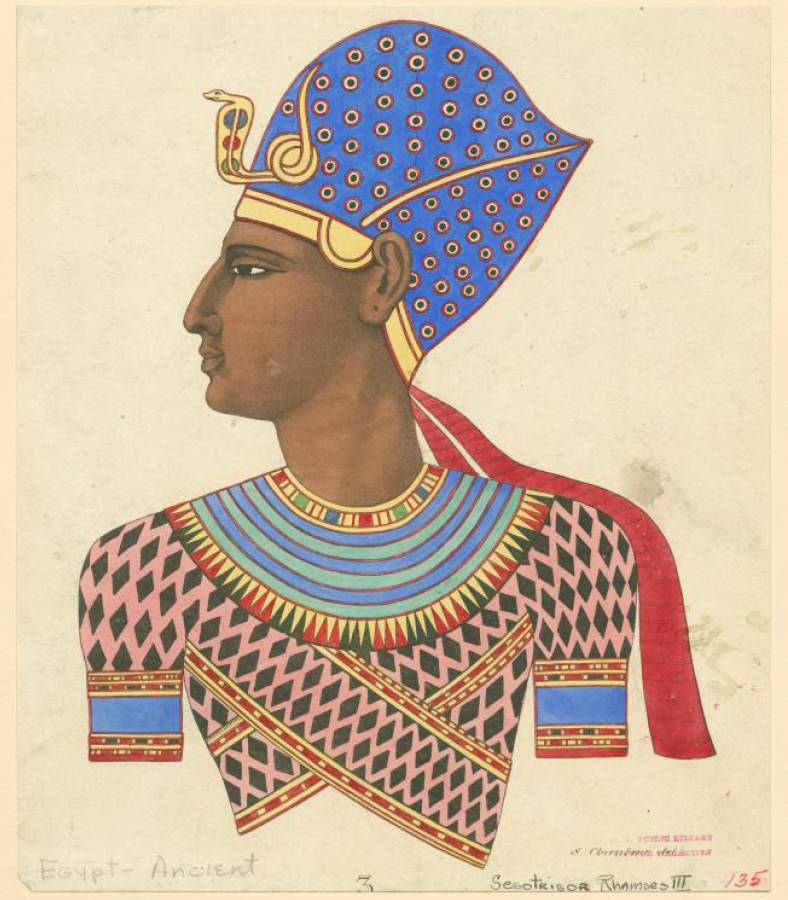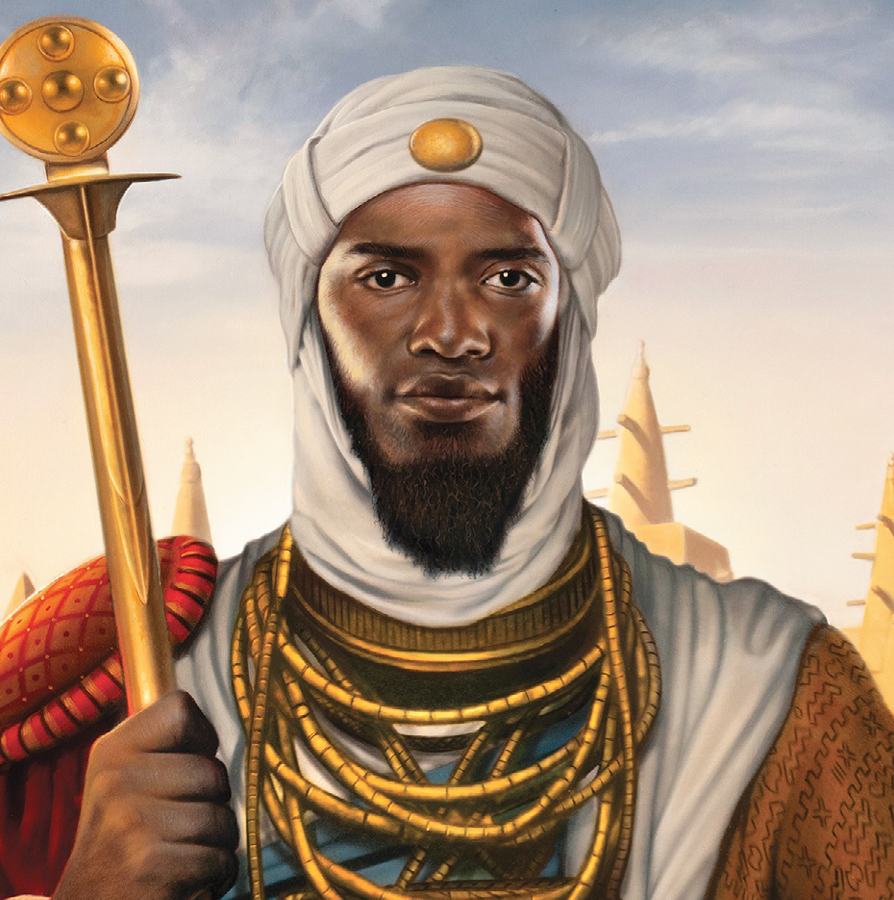Today’s entry examines the legacies of African Kings from two of the world’s most powerful and influential empires
Pharaoh Ramses II
Adapted from Ancient Egypt Online
Ramses II (aka Ramesses II, Rameses II or Sese) was the third pharaoh of the 19th dynasty. He was one of the most powerful and influential pharaohs of ancient Egypt, taking the throne of Egypt in his early 20s (around 1279 B.C.) and ruling for 66 years.

Architectural Accomplishments
Perhaps the best-known achievements of Ramses II are his architectural endeavors, most notable the Ramesseum and the temples of Abu Simbel. Ramses II’s interest in architecture resulted in the creation of more monuments than any of the other ancient Egyptian pharaohs. A significant number of architectural tributes attributed to Ramses II still dominate the landscape of Egypt today.
The Ramesseum is a memorial temple complex situated close to Luxor (even closer to Qurna). Although it is in ruins now, it is still recognizable for the large Pylon of Ramesses inside, which is useful as a historical document.
Pylon is the Greek word for the entrance of an Egyptian temple. The pylon is inscribed with images showing Ramesses victories over the Hittites in war, and the subsequent peace treaty that ensued. This pylon, along with other inscriptions and temples created during Ramses II’s reign, shows that this pharaoh wanted to be remembered for his influence on military, political, and religious life.
Also at the Ramesseum are the remains of a gigantic Ramses II statue. It used to be 56ft high, but now only parts of the torso and base remain.
The Abu Simbel temples, two massive twin rock temples, were also built by Ramses II. They are situated in Nubia (South Egypt), close to Lake Nasser, and were meant to commemorate his reign, and that of his queen, Nefertari.
Another ancient city, Abydos (known for its mythological inscriptions), was used by Ramses II to record the history of his reign and that of his ancestors, providing a wealth of knowledge for future generations on the accomplishments of these pharaohs.
The well-known Ramses II statue unearthed at Memphis was thought to have been commissioned by Ramses II himself. It has shown people today how large of an impact he had on the artwork of his day. Other sites have yielded similar large Ramses II statues.
Ramses II: Military Impact
The reign of Ramses II was marked by numerous military battles, and he became one of the famous Egyptian pharaohs known for his military strength. Much of his reign was occupied with taking back territories that were lost to Egypt during the rule of other ancient Egyptian pharaohs (most notably Akhenaten). Ramses II’s army was 100,000men strong, enormous for that period in time.
Ramses II’s most famous battle is the Battle of Kadesh, which took place at the city of Kadesh (situated in present day Syria). Fought in 1274 B.C. against the Hittites, it was the largest chariot battle ever. Ramesses made a tactical error in that fight by dividing his forces, causing one of his divisions to be swept away. Eventually none of the parties gained victory and Ramesses had to retreat because of logistic difficulties.
The military genius of Ramses II helped to secure Egypt’s borders from foreign invaders and pirates along the Mediterranean and in Libya. He managed to fend off invasions from the Hittites and Nubians.
In addition, his campaigns restored land to Egypt that had been previously lost to these empires. By forming peace treaties with these empires after warring with them, Ramses II helped to solidify Egypt’s borders on all sides, allowing for increased internal stability. Many of these campaigns were completed in the first 20 years of Ramses II’s reign.
Ramses II’s Religious Impact
The religious impact that Ramses II had on Egypt is not to be overlooked, either. After reigning for 30 years, Ramses II celebrated the Sed festival, in which the king was turned into a God.
Because the people of Egypt worshiped Ramses II as a god, it also helped to ensure that his son, who at that point commanded the army, would rise to power following his death, without anyone trying to seize the throne.
Ramses and Moses
A much-debated issue of religion and history alike is the Exodus. Known as the departure of the Israelites from Egypt, this event is considered to have happened under the reign of Ramses II. Whether or not it did happen as the story tells us, scientists found evidence for the existence of the notorious 10 plagues of Egypt (or at least the first nine of them). The events do show a link to the capital city of Pi-Ramses and the grueling period Egypt crossed under the rule of Ramses II.
Ramses II’s Mummy
Ramses II was buried in the Valley of Kings, but had to be replaced because of looting. After a detour, his mummy was moved to tomb DB320, located near Deir el-Bahri, where it would be safe from tomb robbers. In 1881 his body was discovered there and moved to Cairo’s Egyptian Museum.
Mansa Musa
Adapted from National Geographic
Mansa Musa (Musa I of Mali) was the ruler of the kingdom of Mali from 1312 to 1337. During his reign, Mali was one of the richest kingdoms of Africa, and Mansa Musa was among the richest individuals in the world. The ancient kingdom of Mali spread across parts of modern-day Mali, Senegal, the Gambia, Guinea, Niger, Nigeria, Chad, Mauritania, and Burkina Faso.

Mansa Musa developed cities like Timbuktu and Gao into important cultural centers. He also brought architects from the Middle East and across Africa to design new buildings for his cities. Mansa Musa turned the kingdom of Mali into a sophisticated center of learning in the Islamic world.
Mansa Musa came to power in 1312 after the previous king, Abu Bakr II, disappeared at sea. Mansa Abu Bakr II had departed on a large fleet of ships to explore the Atlantic Ocean, and never returned. Mansa Musa inherited a kingdom that was already wealthy, but his work in expanding trade made Mali the wealthiest kingdom in Africa. His riches came from mining significant salt and gold deposits in the Mali kingdom. Elephant ivory was another major source of wealth.
When Mansa Musa went on a pilgrimage (hajj) to Mecca in 1324, his journey through Egypt caused quite a stir. The kingdom of Mali was relatively unknown outside of West Africa until this event. Arab writers from the time said that he travelled with an entourage of tens of thousands of people and dozens of camels, each carrying 300 pounds of gold.
While in Cairo, Mansa Musa met with the Sultan of Egypt, and his caravan spent and gave away so much gold that the overall value of gold decreased in Egypt for the next 12 years. Stories of his fabulous wealth even reached Europe. The Catalan Atlas, created in 1375 by Spanish cartographers, shows West Africa dominated by a depiction of Mansa Musa sitting on a throne, holding a nugget of gold in one hand and a golden staff in the other. After the publication of this atlas, Mansa Musa became cemented in the global imagination as a figure of stupendous wealth.
After his return from Mecca, Mansa Musa began to revitalize cities in his kingdom. He built mosques and large public buildings in cities like Gao and, most famously, Timbuktu. Timbuktu became a major Islamic university center during the 14th century due to Mansa Musa’s developments. Mansa Musa brought architects and scholars from across the Islamic world into his kingdom, and the reputation of the Mali kingdom grew. The kingdom of Mali reached its greatest extent around the same time, a bustling, wealthy kingdom thanks to Mansa Musa’s expansion and administration.
See more Black History content at schoolcraft.edu/BHM

